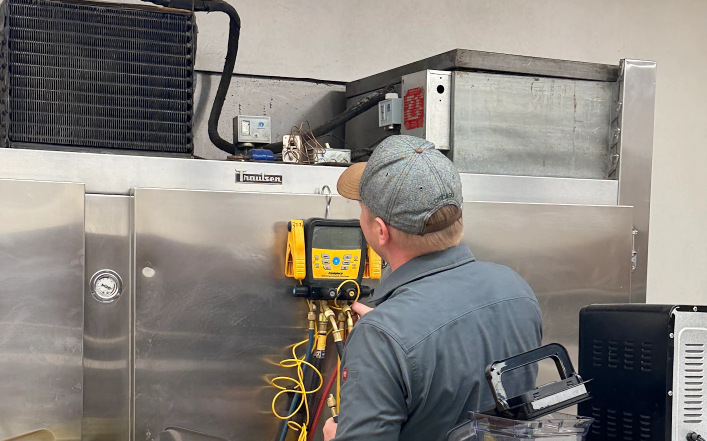Walk-in Cooler & Freezer: How to Diagnose Common Issues
Explore key considerations for a successful walk-in refrigeration system installation in your business.

The author of the article:
Lorem ipsum dolor sit amet, consectetur adipiscing elit. Suspendisse varius enim in eros elementum tristique. Duis cursus, mi quis viverra ornare, eros dolor interdum nulla, ut commodo diam libero vitae erat. Aenean faucibus nibh et justo cursus id rutrum lorem imperdiet. Nunc ut sem vitae risus tristique posuere.
First, off, it’s important to understand that while alk-in coolers and freezers may seem similar, they do have a few distinct applications and operational differences.
A walk-in cooler typically operates at temperatures above 32°F (0°C), mainly to keep items cold but not frozen.
Conversely, walk-in freezers operate below 32°F, ensuring items remain frozen solid.
The mechanics of each are tailored to these temperature ranges, leading to unique challenges in troubleshooting issues.
Exploring Common Issues With-In Freezers and Coolers
Common Issues With Walk-In Freezers
1. Frost Build-Up
One of the most noticeable issues with walk-in freezers is the accumulation of frost. Frost can form due to a variety of reasons, from environmental to equipment-related.
Symptoms: Excessive frost on the walls, ceiling, or shelving.
Problem: Excessive frost indicates potential door seal issues or frequent door openings which allow warm, moist air to enter. Over time, this can compromise the freezer's efficiency, leading to higher energy costs. If left unchecked, it may also pose a risk of product spoilage as the frost can reduce the overall temperature consistency inside the freezer.
Troubleshooting Tips:
- Check the door seals for wear or damage and replace if necessary.
- Reduce the frequency of door openings.
- Consider adding a defrost cycle if not already present.
2. Temperature Fluctuations
Walk-in freezers are designed to maintain consistent low temperatures. However, various factors can disrupt this consistency, leading to temperatures that rise and fall beyond the desired range.
Symptoms: Unstable temperatures, with the freezer failing to maintain desired cold levels.
Problem: Causes of these fluctuations can range from faulty thermostats failing to read or maintain temperatures correctly, to refrigerant leaks which directly impact the cooling capacity.
Troubleshooting Tips:
- Calibrate the thermostat.
- Inspect for refrigerant leaks and consult a technician if any are found.
- Ensure evaporator and condenser coils are clean.
3. Loud Noises
While walk-in freezers, like many machines, produce operational sounds, sudden loud or unusual noises can be alarming and indicate underlying issues.
Symptoms: Unexpected or loud noises coming from the compressor or fans.
Problem: These sounds can signal a mechanical issue within the system. It might be due to components wearing out, misalignments, or even foreign objects interfering with the fans or compressor. If left unchecked, this could lead to complete system failure or more expensive repairs down the line.
Troubleshooting Tips:
- Check for obstructions or debris in fan blades.
- Determine if the noise is from the compressor or fans and consult a technician.
Common Issues With Walk-In Coolers
1. Not Cooling At All
The cooler does not provide any cooling effect.
Symptoms: No noticeable temperature decrease within the cooler.
Problem: Possible thermostat malfunction or system failure.
Troubleshooting Tips:
- Confirm temperature setting and listen for a click from the thermostat.
- Check if both the fan and compressor are running.
- Inspect the side glass for any bubbling, indicating a potential refrigerant leak.
2. Water Leakage
Unlike walk-in freezers, coolers operate at temperatures where condensation is more prevalent. If the system isn't managing moisture effectively, water leaks can become a frequent problem.
Symptoms: Puddles of water or increased humidity inside the cooler.
Problem: Water leaks often result from a clogged drain line or issues with the condensation process. Apart from creating a potential slip hazard for anyone entering the cooler, it can also lead to an environment conducive to mold growth and potential spoilage of stored items.
Troubleshooting Tips:
- Check the drain line for any clogs or obstructions and clear them.
- Ensure the cooler's condensation pan isn't overflowing; empty and clean as necessary.
- Inspect door seals to ensure they're intact and sealing properly to prevent excess humid air from entering.
- Ensure the evaporator coils are free from frost build-up or debris which could impede proper condensation.
- If the cooler has a condensation pump, ensure it's functioning correctly.
3. Inadequate Cooling
A fundamental function of walk-in coolers is to maintain a specific temperature range. When the cooling process is compromised, it can impact not only the products inside but also increase energy consumption.
Symptoms: The cooler not maintaining the desired temperature, with items feeling less cold than they should.
Problem: A malfunctioning thermostat might not detect the actual temperature accurately, leading to overheating or overcooling. Blocked vents can restrict airflow, leading to uneven cooling. Refrigerant issues, on the other hand, can diminish the cooler's cooling capacity. Any of these scenarios directly affect the safety, freshness, and longevity of stored products.
Troubleshooting Tips:
- Regularly maintain the unit.
- Ensure the condenser and evaporator fans are clean and running efficiently.
4. Strange Odors
An unexpected smell coming from a cooler can be a cause for concern. Coolers, being enclosed spaces, can trap and amplify odors, making them noticeable sooner.
Symptoms: Unpleasant smells emanating from the cooler.
Problem: These odors can arise from mold growth due to excessive moisture, spoiled items, or even decaying pests trapped inside. Such environments pose potential health risks and can compromise the quality of other stored items due to cross-contamination.
Troubleshooting Tips:
- Regularly inspect and clean the interior of the cooler to prevent the accumulation of spoiled items.
- Check for and remove any visible mold growth. Clean the affected area with a mixture of water and mild detergent, then thoroughly dry it.
- Ensure good ventilation within the cooler. Check if vents or fans are obstructed and clear any blockages.
- Consider placing activated charcoal or baking soda inside the cooler to absorb and neutralize odors.
- Check for signs of pests and consider implementing pest control measures if any are found.
- Ensure door seals are functioning properly to prevent external contaminants from entering.
5. Freezing Over
Walk-in coolers, due to more moisture and lower temperatures, can have their evaporator coils freeze.
Symptoms: Frost build-up, decreased cooling efficiency.
Problem: Excessive moisture causing the evaporator coils to freeze.
Troubleshooting Tips:
- Check for frost build-up regularly.
- Defrost as needed to prevent freezing of coils.
DIY Diagnostics vs. Professional Help
Sometimes, business owners can perform certain diagnostic steps on their own when issues arise with their walk-in coolers or freezers.
But sometimes, these issues require professional help to diagnose.
Here are some informational points to help you understand which are which, and what may require the presence of a professional technician.
DIY Diagnostics
These are diagnostic steps that business owners may be able to accomplish on their own.
- Visual Checks: Business owners can easily check for visible issues like frost build-up, water leakage, or blocked vents.
- Temperature Monitoring: Keeping an eye on the temperature gauge and checking if it corresponds to the actual felt temperature can provide early warnings.
- Door Seals: Ensuring the door seals are clean and intact can prevent energy wastage and temperature fluctuations.
Professional Diagnostics
These diagnostic steps will most likely require professional assistance.
- Refrigerant Levels: If there's a suspicion of refrigerant leakage or issues, professionals should be consulted.
- Electrical and Mechanical Issues: For concerns related to wiring, compressors, or other intricate components, seeking professional help is wise.
- Thermostat Calibration: To ensure accurate temperature readings and controls, experts should calibrate thermostats.

Conclusion
Maintaining the optimal function of walk-in coolers and freezers is vital for businesses.
Recognizing common issues and understanding when to call for professional help ensures efficient operation and safeguards the quality and safety of stored items.
Being proactive in regular checks and diagnostics can save time, money, and prevent potential losses.

Other articles
Get your appliances fixed today
Our website uses 🍪 cookies. By clicking “Accept”, you agree to our Privacy policy








